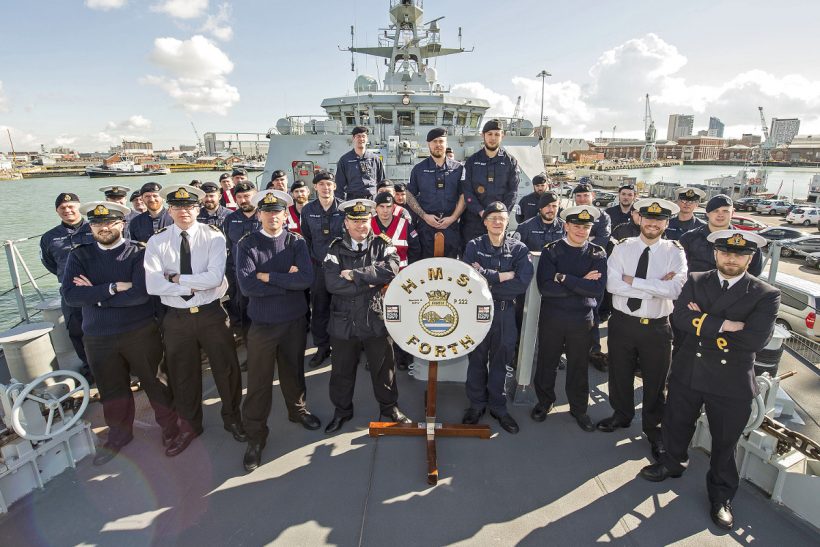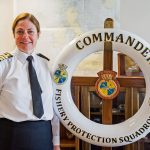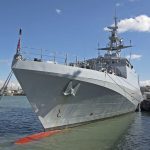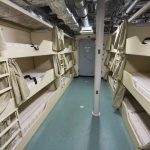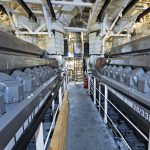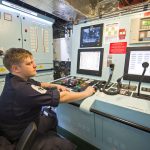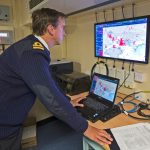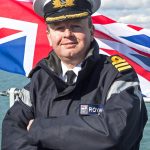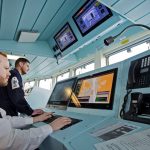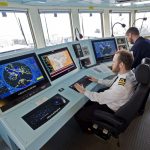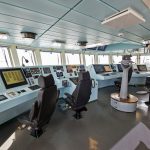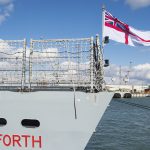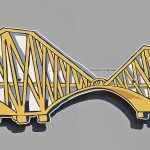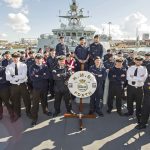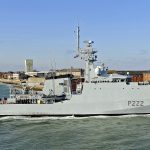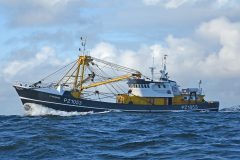HMS Forth, the first of the Royal Navy’s new Batch 2 River-Class Offshore Patrol Vessels (OPV), arrived at its home base of Portsmouth at the end of February (Fishing News, 8 March).
The Commanding Officer of the Fishery Protection Squadron, Commander Sarah Oakley RN, immediately extended an invitation for Fishing News to have a dedicated tour of the new vessel. John Periam reports.
(Photos: Geoffrey Lee)
HMS Forth P 222 is the first of its class and will be followed by HMS Medway, Trent, Tamar and Spey. Of 90.5m LOA and capable of steaming at 24 knots, these sisterships are a significant upgrade to the current Fisheries Protection fleet, which was designed and built 15 years ago.
Commander Oakley said: “I am delighted to see HMS Forth alongside in Portsmouth to start her generation process for operations. The new Batch 2 River-class Offshore Patrol Vessels are a step-change capability from our Batch 1 ships, and I look forward to fully exploiting this in the coming years.”
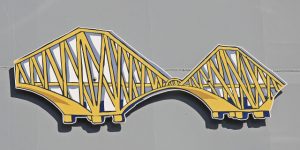
A logo of the iconic Forth railway bridge on the side of the ship gives an immediate link to the source of the vessel’s name.
Standing on the bridge of Forth overlooking Portsmouth Harbour and the Isle of Wight, Commander Bob Laverty started the visit by explaining a little about his past, and his links to the Fishery Protection Squadron (FPS).
“Having joined the Navy in 1989, I spent seven years as a submariner followed by a variety of roles on frigates, destroyers and aircraft carriers before I joined as the captain of HMS Tyne in 2014. HMS Tyne patrolled the UK, Europe and, for the last six months, the Falklands. Following a year’s course in Australia, I returned and joined HMS Forth, taking her out of build and bringing her back into the heart of the Fishery Protection Squadron, at Portsmouth. The current crew formed up at the end of April last year, to work hand-in-hand with BAE Systems,” he said.
The proposed schedule is for Forth to have a couple of months alongside at Portsmouth, where the latest high-tech communications equipment will be fitted and commissioned and the crew trained in its usage. The Navy now actually owns the ship, so the crew are living on board making sure they understand how it works and that it is operationally safe, before she proceeds to sea.
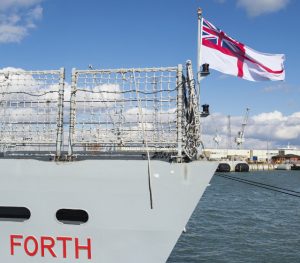
HMS Forth flying the White Ensign at Her Majesty’s Naval Base (HMNB) Portsmouth.
Commander Laverty went on to say, “Initial training will take place along the south coast, and later in Scotland for a three-week work-up sea training. This will be followed by a week off Plymouth, where we will utilise the flight deck for helicopter training – air search radar and our ability to refuel at sea. The addition of a flight deck to the new fleet will be a bonus. HMS Clyde, which is Falklands-based, is the only one with a flight deck of the current fleet. Having been captain of HMS Clyde in the past will set me up perfectly for this role on Forth.
“It will offer us advantages in our other duties relating to maritime security, and allow us access to extra military support if needed. We have 50 extra berths for visiting personnel, such as The Royal Marines. It also offers an opportunity to sustain operations a lot longer. We intend to work with the UK Maritime Coastguard Agency, offering support to its search and rescue role if needed. This is a side that our crews are looking forward to developing.”
When it comes to the UK fishing industry, the advantage of the new fleet will be that the vessels will be larger and faster, operating in more challenging sea conditions as well as being able to spend up to 35 days at sea with a larger crew. It is really about sustainability, offering her a slightly faster speed and longer legs around the UK, with the added bonus of vastly improved technology and communications.
Commander Laverty continued, “We see ourselves working in partnership with the fishing industry. I accept that we are in an enforcement role, to see that the legislation and regulations are adhered to, but that is for the industry as a whole. Part of our role is to engage with fishermen and those in the industry, as well as showing what taxpayers are paying for.
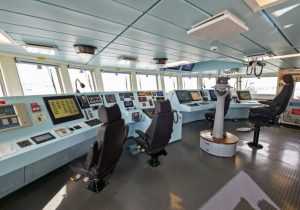
A general view of the bridge on HMS Forth, with all of its new navigation and communications equipment.
“We will certainly carry on working with our colleagues from the MMO; our current boarding crews are involved in training with them. They do a very intense and in-depth course at the National Marine Aquarium in Plymouth, run jointly by the MMO and the FPS staff. Communication with the MMO plays such an important part in our operations as the Fishery Protection Squadron.
“The squadron is a close-knit community, and people often wish to remain, or return to the fold from other postings. Once people get into fish, they like to stay in fish, and there are many reasons for that, one of which is the predictability of their working lives, with a three-watch running profile giving the crews a four-week watch away and two weeks at home, or on courses. Not having a large crew on board also means that everyone gets to know each other well and they support each other.
“Their work is interesting, and it gives them an opportunity to establish a relationship with real people while safeguarding our fishing stocks. When boarding, we are generally received well. Sometimes it can be more challenging, but that might give us an indication that there is something to investigate on board. We are mostly seen by the fishing community as being there to help and protect them. We are always there to give them a hand should a problem arise, even when it comes to engineering issues at sea. If they get into real trouble, we are never far away, and with the new vessels we will be even closer.”
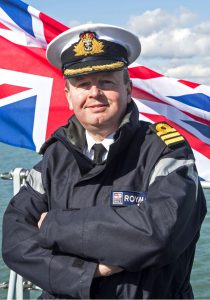
Commander Robert Laverty, commanding officer of HMS Forth.
With a top speed of 24 knots, the new OPVs are four knots faster than their predecessors and also have an increased range of 5,500 nautical miles. This will benefit the squadron in its additional roles in UK exclusive economic zone patrol, as it will become the Navy’s eyes and ears around the UK. Further afield trips will also involve working in the Mediterranean and Caribbean to safeguard the UK’s interests around the world.
“Having Sarah as the Squadron’s Commanding Officer is a real benefit,” said Bob. “We know each other well and have worked together for over 12 years, both in command of vessels at the same time – Sarah on HMS Mersey and myself on Tyne. I can’t stress enough how important communication is in this squadron. It is a team effort, and by doing this, we are able to provide the protection and support to the fishing industry that is required.”
The navigation officer, Lt Tom Sleight, has the role of keeping the vessel safe at all times. His interaction with the fishery protection role is working with the on-board tactical fishery officer, who is responsible for planning the best possible area to patrol and identifying potential targets. They are also supported by the MMO from their headquarters in Newcastle. This is based on fish stocks and what the fishing vessel activity is like, so they can look at contacts of interest.
Tom Sleight said, “HMS Forth is a ‘self-contained ship’, and we are quite a large ship when it comes to the role of fishery protection. Effectively, what we have is the propulsion and thrust technology to be able to berth independently in most weather conditions, in virtually any port in the UK – we have no logistics chain behind us.
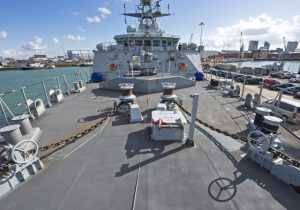
View of the bridge from the bow showing its 30mm cannon and anchor chains.
“If we can fit into a harbour, we will do just that. It is also good for the ship’s company to be able to visit different ports around the UK and meet those in a specific community to show them our technology and support for the fishing industry. This word ‘communication’ is so important, and we do find ourselves at many public events taking place around the UK, which are often related to seafood festivals and nautical events. We provide a large and approachable platform for meeting others.
“Being able to operate in any sea state gives us increased capability when working with other organisations such as the RNLI and Coastguard, including Search and Rescue helicopters.
“When it comes to communications on board Forth, we have specific equipment. This includes VHF for ship-to-ship and UHF for tactical communications, which can be encrypted as well as being used for aircraft communications. There is a bowman link also that gives us shore-based comms direct to other military units – it is their specific network.
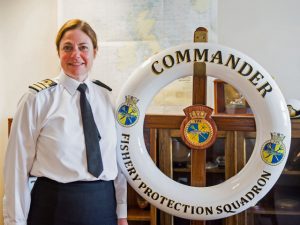
Sarah Oakley Commander Royal Navy, Commander Fishery Protection Squadron
“There is a specialised communication team on board, and they are the hub of all of our systems. It is very important that the right procedures are used when communicating with a fishing vessel. In this role, we are there also to assist the crew if needed. By doing this, it can save time in boarding or in an emergency. I must say, mariners in the UK overall come over as very professional in their clear use of the airwaves.
“This is when the communication between departments such as the National Maritime Centre at Fareham and Forth can make life a lot easier,” added Tom. “We are in Portsmouth at the moment to have the latest communications equipment installed on board. This will really be a bonus, not only for the fishing communities, but should we wish to contact Royal Navy Command relating to escorting duties and people smuggling.
“The build of the 90m HMS Forth took place at BAE Systems on the Clyde. It has 2 x 7.35 MM MAN main engines and a displacement of 2000t. The crew accommodation can take up to 58, and with the new flight deck it will be a formidable vessel when it comes to protecting the UK shores. It also will be able to spend 320 days a year on operational duties.”
In conclusion, Commander Sarah Oakley said: “These ships are more capable than their predecessors in their fishery protection role. The added flight deck will be able to operate up to Merlin size helicopters. What is most important is that we have the dedicated crews who are willing to learn and adapt to the new technology that these vessels will offer.
“Forth is the first of a new class of ships that will help to make our shores a lot safer, while protecting the fishing industry over the next two years of change, as we move away from the EU and take responsibility for our own fishing rules and regulations once again. It’s going to be an exciting time for all!”



